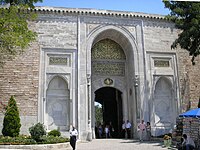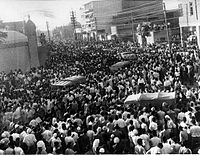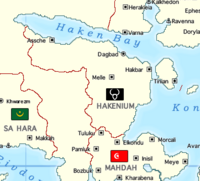Hakenium
Chefdom of Hakenium Hakenium | |
|---|---|
|
Flag | |
| Motto: الثور المقدس | |
| Capital | Dagbad |
| Official languages | Sahrabic |
| Demonym(s) | Hakenian |
| Government | Corrupt democracy, strong ties with the corporations |
| Hannas Sassijn | |
| Tiran Deruyter | |
| Khalif "Big Bull" Wili | |
| Legislature | Parliament and the Grand Council |
| Population | |
• Estimate | 25,710,000 |
| Currency | Euro (€) |
| Driving side | left |
The Chefdom of Hakenium, also known as Hakenium, is a nation situated on the Memopotamian subcontinent in southern Europa on Eurth. The nation's closest neighbours are Mahdah in the south and Sa Hara in the southwest. Hakenium's compassionate population is fiercely patriotic and enjoy great social equality. They tend to view other, more capitalist countries as somewhat immoral and corrupt.[1]
History
Horse raiders
The earliest written Hakenian history dates back to the Hereskus Empire. During the 4th Century, the territory of present-day Hakenium was occupied by pastoral horse-riders from a region called Hakkad or Hagad. Contemporary sources described them as raider tribes that waged small wars on each other. In rare moments, the tribes formed a temporary alliance with each other and went on pillaging raids abroad. After a successful raid, the tribes fought each other over the plundered goods.
Mahdavian occupation
During the final years of the Hereskus Empire (315-330 CE), when its central authority became weak, the Hakkadian raiders invaded and conquered parts of Northern Mahdah. But these gains were quickly lost again, and many Hakkadians were made into slaves by the cruel Mahdavians. The nomadic horsemen settled down and evolved from a nomadic culture into sedentary peoples. They built cities with walls and focussed on their own socio-economic interests. Pacification by the southern Mahdavian kingdom made conflicts less common. One element that persisted was the strong honour culture: disputes were still settled by the sword.
Hakkadian Empire
During the 5th Century, the city of Melle became important under the leadership of Duke Donald or Dawanalid (425-487). The Duke expanded his city-state into a powerful local fiefdom. Quickly rising to become the most powerful lord in the land, he was treated with great respect and granted the rank of Grand Duke. His bold actions and violent demeanour ensured other cities bent to his will. The iron fist of Grand Duke Donald forged the country into a solid Hakkadian Empire. Those nobles who displeased the Duke fled to other regions and cities. This is how Baron Huessien captured the Mahdavian throne and crowned himself Emir of an independent kingdom of Mahdah. When the Hakkadian Empire invaded Mahdah a second time, the Emir's descendant quickly bent the knee to preserve his own head. Once again, Mahdah became a province of Hakkad.
By the 7th Century, the holy teachings of Nabi Hanan were starting to spread. From the village of Raj Frut, his words spoke truth to many lords throughout Memopotamia. The teachings of Nabi Hanan led to great achievements in Salamic theology and science. During the glorious spread of Salam many heretics who failed to convert lost their lives. Influenced by Salam, the Hakkadian Empire experienced its Golden Age. In Dagbad the House of Wisdom was built, where teachers and students from across Memopotamia and beyond collected and translated texts into the Sahrabic language. This Golden Age ended with the extinction of the Donaldic dynasty and siege and capture of Hakbar by Orioni in 1485.
Benevolent decline
In the 16th Century, after the last official blood relative of Grand Duke Donald passed away, the nation lost a great deal of its central authority. In several cities, the rich merchant guilds and local nobles erupted in revolt. The Grand Duke's successor exchanged political privileges for economic concessions. This turned the monarch from absolute into a benevolent ruler.
One of the most important figures was Grand Duke Qarel Rider (year-year). The economic, social and military position of the land was improved under his rule. Diplomatic relations with the Sultanate of Mahdah were re-established, this time more in equal footing Despite these efforts, his heritage was neglected by his successors and the Hakkadian Empire continued its decline. The population, estimated at 30 million in 800 CE, was only 5 million at the start of the 19th century
19th Century
The nation couldn't keep up with the industrial revolution. The famous cavalry was shamefully defeated in battle against modern troops armed with rifles. This traumatic experience led to a popular revolution. The people called upon a strong leader to bring foreign progress to Hakenium.
In 1809, Hannas Pasha the Great (1770–1812) returned from his exile in Sa Hara and became the governor of Dagbad. His rule was efficient at first but weakened as he grew older. He asserted his dominance over the fractured Hakkadian nobility, encouraged trade, and initiated diplomacy with non-Salamid nations. The situation was delicate. The people could be easily stirred up again. Social juistice laws were gifted.
Hannas Pasha the Great was succeeded after a power struggle in 1812 by Wili Pasha, who repelled the foreign attacks against Melle and Hakbar in 1813 and 1816. But Wili Pasha failed to prevent their domination of the desert. He was assassinated in 1817.
After Wili's assassination in 1817, his rival Hannas Pasha the Little took control of the government. He followed in his father's footsteps. The economy was stimulated. Social programs were cut back. An 'adjusted' form of representative democracy was introduced. The military priorities were overhauled.
20th Century
 Hakenium 1901 - The Hakenian armed forces, in order to keep up with the recent innovations, often needed to improvise.
Hakenium 1901 - The Hakenian armed forces, in order to keep up with the recent innovations, often needed to improvise. Hakenium 1916 - Coronation of King Wili II (1885-1933).
Hakenium 1916 - Coronation of King Wili II (1885-1933). Hakenium 1922 - The practice of slavery is abolished.
Hakenium 1922 - The practice of slavery is abolished. Hakenium 1933 - Coronation of King Kazi (1912-1938).
Hakenium 1933 - Coronation of King Kazi (1912-1938). Hakenium 1938 - Coronation of King Wili III (1935-1955).
Hakenium 1938 - Coronation of King Wili III (1935-1955).1955 - Coup d'état by the Hakenian Army. King Wili III is executed. General Mark al-Kraam controls Hakenium through military rule
1963 - Mark al-Kraam is overthrown by Colonel Harry al-Lemal in another coup.
 Hakenium 1968 - Harry al-Lemal is overthrown by the Ba'dkuip Party and Qor al-Bakker becomes president.
Hakenium 1968 - Harry al-Lemal is overthrown by the Ba'dkuip Party and Qor al-Bakker becomes president. Hakenium 1979 - Qor al-Bakker is replaced by the strongman Hannas Sassijn (1947-present).
Hakenium 1979 - Qor al-Bakker is replaced by the strongman Hannas Sassijn (1947-present).
Geography
The Hakenium nation exercises influence in much of the Northern Memopotamian peninsula. The nation is divided into three provinces or territories: Urban zone, the Grain Belly, the Western province.
Urban zone
The main part of the country. More than half of the nation's inhabitants live here, working their behinds off, consume massively and enjoying the best education for a few euros.
- Dagbad. As the capital of the Chefdom, this northern city house houses many official buildings and locations. The government departments and administration are housed in Bull Tower #1, while the main church for the Church of Haken Rider is found in the nearby Bull Tower #2. Dagbad has a large harbour, where the Home fleet lays anchored. It also has the biggest airport in the country, Big Wili International Airport. The skyline is dominated by the skyscrapers and artificial green is planted on every possible spot. Fun fact: the average Dagbader spends 1/12 of his life in traffic.
- Hakbar. Frequented by many, tolerated by some, generally described as a boring place. Hakbar has the largest harbour in the nation and is home to the commercial fleet. The remainder of the war fleet outside Dagbad operate from here. Unemployment is very low here, contrary to the rest of Hakenium, as there is a large presence of heavy industry. Fun fact: the city produces 90% of all cars in Hakenium.
- Melle. As a former seat of power, this old capital combines both modern and historical buildings in a cacophony of styles. Several air force bases are located nearby. Numerous important companies have their HQ seats here, including the (in)famous HC Donalds Corporation.
Grain Belly
It has a large minority of Mahdavians, which are laid-back, religious and hard-working people. Cattle are bred here and farmers try to make the most of the infertile lands. The rough terrain makes them good soldiers. Many people living here have barbaric ancestors.
- Plot City. Relatively new city. Famous for its prefab buildings and its enormous tree museum, collecting over 800 varieties of national plants, many that are extinct and now can only be found here. Home to the Donaldic Armored Division, the meanest men in the army and led by Colonel Harry Plotter. They are known to be the only armoured divisions without black-and-white spotted tanks.
Western province
Bigtopians are very sceptic of the government and are always in for some more autonomy.
- Topia. Neon rules the night here. Hotels and casinos attract the beau monde of Hakenium. Villas are a plague just outside the city. The Topian Bull-ball team has been the nation's champion for the last nine years, which makes it harder for the urbanites to look down upon the Bigtopians, but they manage anyway.
Politics
The government -- a sprawling, bureaucracy-choked morass -- juggles the competing demands of Education, Social Welfare, and Healthcare. The average income tax rate is 38%, but much higher for the wealthy. A large private sector is dominated by the Information Technology industry.
Foreign Affairs
Hakenium is a founding member of The League of the Treaty (LT).[2]
Military
In 2006 the nation clashed with Ide Jima over the nearby island of Tinian.[3]
Economy
The government extracts trade concessions from poor nations in exchange for humanitarian aid, government-run brothels can be found on every street corner, the ban on cars has been repealed, and dog breeding has been banned in accordance with recent animal experimentation laws. Crime is well under control.
Culture
Major minorities include Mahdavians and Plotians. The official religion in Hakenium is The Church of Haken Rider which uses the Saint Hannes cross as its religious symbol. Hakenium's national animal is the cow and its currency is the Euro.
References
- ↑ The Holy Chefdom of Haken Rider (March 22, 2005)
- ↑ The League of the Treaty (April 28, 2007)
- ↑ Troubles in Tiny Tinian (April 26, 2006)
See also
- https://www.nationstates.net/page=boneyard?nation=haken_rider (main nation)
- https://www.nationstates.net/page=boneyard?nation=hakenium (RP puppet)
- https://forum.nationstates.net/memberlist.php?mode=viewprofile&u=521 (NS forum account)
- https://www.europans.com/profile/99-haken/ (Eurth account)








